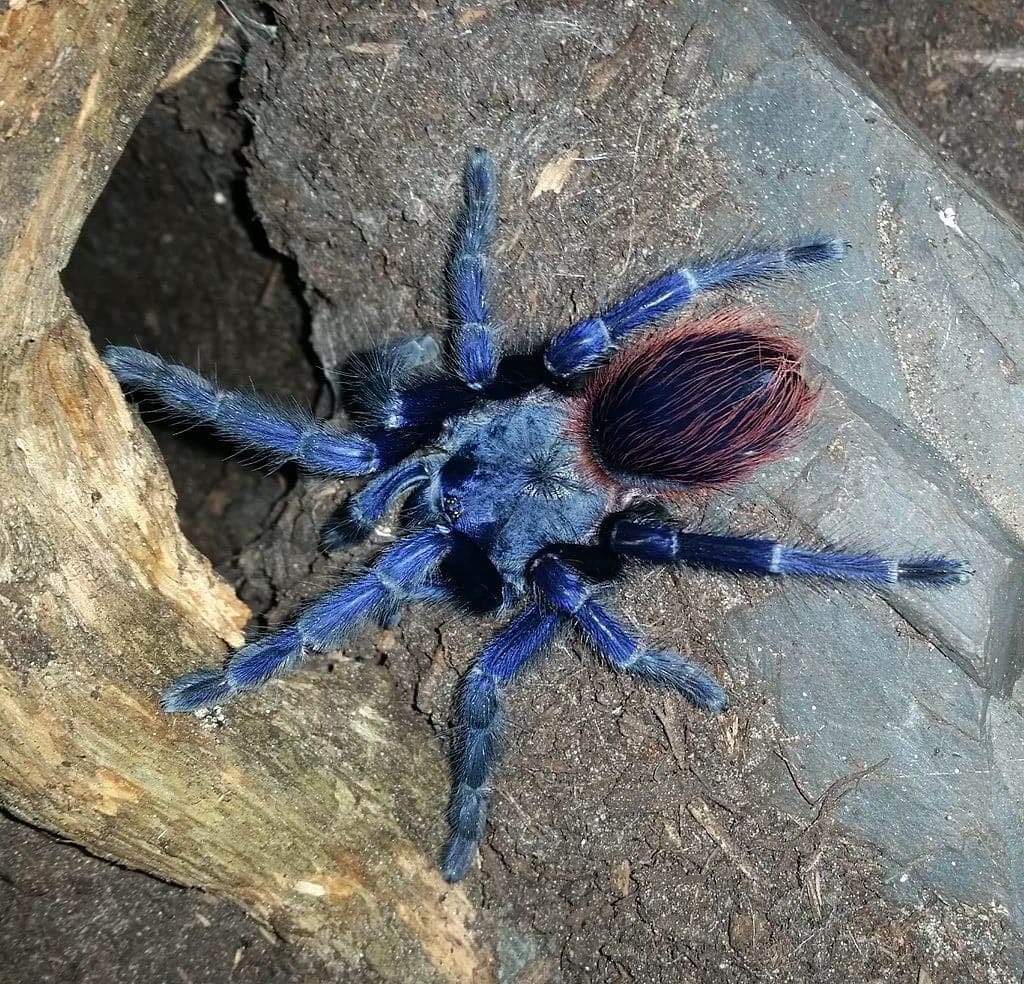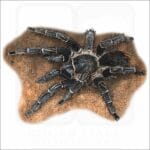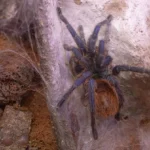Get ready to dive into the world of the mesmerizing Brazilian Blue Tarantula! This ultimate guide will uncover everything you need to know about these captivating creatures. From their vibrant blue hue to their curious behaviors and specific care needs, we’ll delve into every aspect of this enchanting arachnid. Whether you’re a seasoned tarantula pro or just starting to explore these fascinating animals, this guide will equip you with all the knowledge you need to appreciate their beauty and provide the best possible care.
Unveiling the Allure of the Brazilian Blue Tarantula
Thinking about welcoming a Brazilian Blue Tarantula into your life? They are absolutely stunning creatures, known for that dazzling blue color that seems to shimmer in the light. Let’s dive into what makes these tarantulas so special and explore the best practices for their care.
A Closer Look at Their Captivating Appearance
When fully grown, these tarantulas are pretty impressive, with their legs spanning about 5 to 6 inches. And that blue color? It’s even more intense in adults, with reddish hairs adding to their dramatic look. Younger ones start off black with reddish hairs, so they go through quite a transformation! Males tend to be a bit smaller and slimmer than their female counterparts.
Unveiling Their True Personality: More Chill Than Thrill
Now, don’t let their looks intimidate you. Brazilian Blue Tarantulas are renowned for being pretty laid-back. They’d much rather hang out in their burrows than cause any trouble. That makes them a good choice even if you’re new to the world of tarantulas.
Of course, like any creature, they have their limits! If a Brazilian Blue Tarantula feels threatened, they might flick irritating hairs from their abdomen as a warning. And yes, they do have venom, but bites are pretty rare.
These arboreal adventurers also like to climb! They’re not just ground dwellers; they’ll make use of vertical space too.
Creating a 5-Star Tarantula Home
Providing your Brazilian Blue Tarantula with the right environment is key to their well-being. A 10-gallon tank is a good size to start with. Make sure you add enough substrate (the stuff they walk and burrow on) so they can really dig in. Things like coconut fiber or peat moss work well because they hold moisture, which is important for these tarantulas. Don’t forget to add some climbing branches and a secure lid with good ventilation—you don’t want any escapes!
Speaking of important, let’s talk temperature and humidity. Aim for a temperature around 75 to 80 degrees Fahrenheit (that’s roughly 24 to 27 degrees Celsius) and a humidity level between 60% to 70%. Think of it as recreating their natural rainforest home.
What’s on the Menu?
On the menu for a Brazilian Blue Tarantula? Think crickets, roaches, and mealworms—the classic insect buffet. Older tarantulas can even handle a pinkie mouse every now and then. And don’t forget a shallow dish of water!
With good care, these amazing creatures can live a long time—sometimes even up to 20 years! That’s a lot of time to enjoy their company.
Protecting Our Blue Wonders
Sadly, these beautiful tarantulas are facing habitat loss in their native Brazil, which is why they are now considered endangered. That’s where responsible breeders come in. They play a vital role in making sure we don’t lose these creatures forever. Always make sure you’re getting your tarantula from a reputable breeder who prioritizes the well-being of their animals.
A Few More Words of Wisdom
- While they’re generally docile, avoid excessive handling. It stresses them out!
- Always do your research. The more you know about these fascinating creatures, the better you can care for them.
Owning a Brazilian Blue Tarantula is a rewarding experience. You get to share your life with a truly incredible animal. Just remember to prioritize their well-being, and you’ll be rewarded with a happy, healthy tarantula companion.
Are Brazilian Blue Tarantulas Aggressive?
You might imagine a creature sporting such a dazzling blue outfit would want to show off, right? But when it comes to Brazilian Blue Tarantulas, their personalities are actually quite the opposite of their flashy looks. These guys are much more likely to scurry away and hide than pick a fight. They’re like the shy introverts of the tarantula world!
The truth is, Brazilian Blue Tarantulas would much rather avoid a confrontation altogether. Think of it this way: running away means they stay safe, and that’s their number one priority. Now, if they do feel super threatened and cornered, they might try to scare you off first. Picture them rearing up with their front legs raised, like they’re saying, “Back off!” They might even flick some itchy hairs at you for good measure.
Biting? That’s really a last resort for these tarantulas. They only do it if they feel like there’s absolutely no other way out of a sticky situation. So, as long as you’re respectful of their space, provide a comfy and secure enclosure, and don’t go poking and prodding them unnecessarily, chances are they’ll be content to just hang out in their own little world. Remember, owning a Brazilian Blue Tarantula is a bit like having a beautiful, but slightly timid, roommate!
Is A Blue Tarantula Venomous?
Are you wondering if those striking blue tarantulas, specifically the Brazilian Blue Tarantula, pack a dangerous bite to go with their vibrant colors? The short answer is yes, they are venomous, but don’t worry too much! Their venom is generally not a big deal for us humans.
Think of it this way: their venom is designed for their prey – insects and other small critters that end up on their dinner menu. While a bite might cause some discomfort, it’s unlikely to be medically serious for most people.
Now, don’t get the wrong idea, these tarantulas aren’t out to get you. The Brazilian Blue Tarantula is actually known for being pretty chill and even a bit timid! They’d much rather scurry away and hide than pick a fight.
Having said that, even the calmest creatures have their limits. If a Brazilian Blue Tarantula feels seriously threatened, they might raise their front legs and flash their fangs in a warning posture. If that doesn’t work, they might try flicking irritating hairs from their abdomen at the perceived danger – talk about a hairy situation! Biting is truly a last resort for them, something they’ll only do if they feel there’s absolutely no other option.
If you’re considering having one of these beauties as a pet, that’s awesome! Just remember to respect their space and handle them carefully and infrequently. Give them a comfortable and secure enclosure that mimics their natural environment, and they’ll be happy campers (or, well, happy burrowers!).
How Big Does a Brazilian Blue Tarantula Get?
Curious about the size of a Brazilian Blue Tarantula? They’re not exactly pocket-sized, but they’re not going to challenge a Goliath Birdeater for the title of “biggest spider in the world” either.
Imagine a creature with legs spanning about the size of your hand – that’s a pretty good visual for a fully grown Brazilian Blue. On average, their legs reach about 5 to 6 inches long. That’s big enough to impress, but not quite big enough to star in a horror movie (unless you’re really afraid of spiders!).
Now, keep in mind, these are just averages. Just like people, spiders can vary in size. Think about it – you probably know someone who’s really tall and someone who’s on the shorter side. The same goes for our eight-legged friends. Some Brazilian Blues might be a little smaller, while others might be a bit bigger. It all depends on things like their diet and the environment they live in.
To give you a better idea of how they measure up, let’s compare them to some other popular tarantulas:
| Tarantula Type | Average Leg Span |
|---|---|
| Goliath Birdeater | 10-12 inches – Woah! That’s one big spider! |
| Chaco Golden Knee | 6-8 inches – A respectable size, for sure. |
| Brazilian Blue | 5-6 inches – Right in the middle! |
| Mexican Redknee | 4-5 inches – Getting a bit smaller here. |
| Pink Toe Tarantula | 3-4 inches – Now we’re talking pocket-sized! |
As you can see, the Brazilian Blue falls somewhere in the middle. They’re definitely not the biggest kids on the block, but they’re not exactly tiny either.
It’s worth noting that our understanding of these creatures is always evolving. Scientists are constantly learning new things about spiders, so what we know about their size and other characteristics might change over time. That’s the beauty of science – it’s always an adventure!
Behold the beauty of other fascinating creatures:
Immerse yourself in the world of the nocturnal primate with large, captivating eyes, the big eyed lemur. Its striking features and unique adaptations make it a must-see. Explore the fascinating world of these gentle creatures and learn about their remarkable abilities that help them thrive in their nocturnal environment.
Witness the extraordinary duo, the bactrian pair, with their unique double humps. Discover their incredible journey from the vast steppes of Central Asia to their current protected habitats. Learn about their exceptional adaptations and the challenges they face as one of the world’s most endangered species.

















1 thought on “The Brazilian Blue Tarantula: A Complete Care and Information Guide”
Comments are closed.